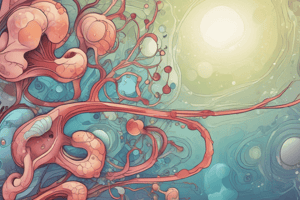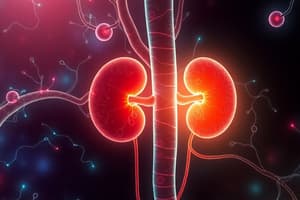Podcast
Questions and Answers
What is a key characteristic associated with an arterio-venous fistula in the context of dialysis?
What is a key characteristic associated with an arterio-venous fistula in the context of dialysis?
- Decreased risk of infection
- Hypotension
- Palpable 'thrill' (correct)
- Reduced blood flow
Sialosis, secondary to renal impairment and dialysis, is characterized by what condition affecting the salivary glands?
Sialosis, secondary to renal impairment and dialysis, is characterized by what condition affecting the salivary glands?
- Enlargement (correct)
- Neoplastic growth
- Atrophy
- Infective inflammation
In patients with renal disease, what potential consequence should dental practitioners be aware of regarding a heavy protein load, such as from swallowed blood?
In patients with renal disease, what potential consequence should dental practitioners be aware of regarding a heavy protein load, such as from swallowed blood?
- Loss of renal reserve (correct)
- Decreased cardiovascular risk
- Reduced risk of infection
- Increased renal reserve
A patient presents with acute renal colic radiating from the loin to the groin, accompanied by nausea and vomiting. Which anatomical structure is primarily involved in transmitting this pain?
A patient presents with acute renal colic radiating from the loin to the groin, accompanied by nausea and vomiting. Which anatomical structure is primarily involved in transmitting this pain?
Which of the following conditions is least likely to be directly associated with the formation of renal calculi?
Which of the following conditions is least likely to be directly associated with the formation of renal calculi?
Which of the following is characteristic of early Chronic Kidney Disease (CKD)?
Which of the following is characteristic of early Chronic Kidney Disease (CKD)?
A patient presents with perioral oedema. Which of the following should the dentist prioritize to determine the cause?
A patient presents with perioral oedema. Which of the following should the dentist prioritize to determine the cause?
What is the primary reason prophylactic, low-dose aciclovir might be administered to a renal transplant recipient?
What is the primary reason prophylactic, low-dose aciclovir might be administered to a renal transplant recipient?
A patient with diabetic nephropathy exhibits unexpectedly severe periodontal disease despite maintaining good oral hygiene. What should the dentist consider?
A patient with diabetic nephropathy exhibits unexpectedly severe periodontal disease despite maintaining good oral hygiene. What should the dentist consider?
What is the MOST likely oral manifestation of renal osteodystrophy that may cause a patient to seek dental treatment?
What is the MOST likely oral manifestation of renal osteodystrophy that may cause a patient to seek dental treatment?
A dentist is treating a patient who had a renal transplant 7 months ago. According to current guidelines, what consideration should be given to antibiotic cover prior to invasive dental procedures?
A dentist is treating a patient who had a renal transplant 7 months ago. According to current guidelines, what consideration should be given to antibiotic cover prior to invasive dental procedures?
Which hematological change associated with renal disease is MOST likely to impact dental treatment planning due to increased bleeding risk?
Which hematological change associated with renal disease is MOST likely to impact dental treatment planning due to increased bleeding risk?
During the assessment of a patient with suspected renal insufficiency, a dentist notes pale oral mucosa, glossitis, and angular cheilitis. Which of the following underlying mechanisms is MOST likely contributing to these specific oral findings?
During the assessment of a patient with suspected renal insufficiency, a dentist notes pale oral mucosa, glossitis, and angular cheilitis. Which of the following underlying mechanisms is MOST likely contributing to these specific oral findings?
What is the underlying cause of sialosis observed in dialysis patients?
What is the underlying cause of sialosis observed in dialysis patients?
Why should dental practitioners be aware of a patient's cardiovascular status when managing patients with CKD?
Why should dental practitioners be aware of a patient's cardiovascular status when managing patients with CKD?
Which of the following is the most common type of renal calculi?
Which of the following is the most common type of renal calculi?
In the context of renal cancer, what does the term 'hematuria' refer to?
In the context of renal cancer, what does the term 'hematuria' refer to?
Which investigation is considered the 'gold standard' for diagnosing nephrolithiasis?
Which investigation is considered the 'gold standard' for diagnosing nephrolithiasis?
What is the primary mechanism by which an arterio-venous fistula (AVF) assists in hemodialysis?
What is the primary mechanism by which an arterio-venous fistula (AVF) assists in hemodialysis?
Which of the following is LEAST likely to be a direct cause of Acute Kidney Injury (AKI)?
Which of the following is LEAST likely to be a direct cause of Acute Kidney Injury (AKI)?
In a patient undergoing dialysis, what is the significance of a palpable 'thrill' associated with an arterio-venous fistula?
In a patient undergoing dialysis, what is the significance of a palpable 'thrill' associated with an arterio-venous fistula?
A patient undergoing haemodialysis presents with prolonged bleeding after a routine extraction. Beyond immediate haemostatic measures, what is the MOST appropriate next step considering their renal status?
A patient undergoing haemodialysis presents with prolonged bleeding after a routine extraction. Beyond immediate haemostatic measures, what is the MOST appropriate next step considering their renal status?
A patient with end-stage renal disease (ESRD) on hemodialysis requires multiple extractions due to severe periodontitis. Despite meticulous technique, significant intraoperative and postoperative bleeding is encountered. What highly specialized intervention, though not routinely considered, might be explored in consultation with the patient's nephrologist and hematologist to optimize hemostasis?
A patient with end-stage renal disease (ESRD) on hemodialysis requires multiple extractions due to severe periodontitis. Despite meticulous technique, significant intraoperative and postoperative bleeding is encountered. What highly specialized intervention, though not routinely considered, might be explored in consultation with the patient's nephrologist and hematologist to optimize hemostasis?
What is the underlying cause of nocturia in the early stages of Chronic Kidney Disease (CKD)?
What is the underlying cause of nocturia in the early stages of Chronic Kidney Disease (CKD)?
A patient with Chronic Kidney Disease (CKD) presents with hypertension. What physiological change directly contributes to this?
A patient with Chronic Kidney Disease (CKD) presents with hypertension. What physiological change directly contributes to this?
Why are renal transplant recipients at an increased risk of developing oral candidiasis, herpes simplex, and zoster virus infections?
Why are renal transplant recipients at an increased risk of developing oral candidiasis, herpes simplex, and zoster virus infections?
Which of the following best describes the current recommendation for antibiotic prophylaxis for dental treatment in patients who have undergone renal transplantation?
Which of the following best describes the current recommendation for antibiotic prophylaxis for dental treatment in patients who have undergone renal transplantation?
A patient with diabetic nephropathy exhibits unexpectedly severe periodontal disease despite rigorous oral hygiene practices. What is the MOST likely explanation for this observation?
A patient with diabetic nephropathy exhibits unexpectedly severe periodontal disease despite rigorous oral hygiene practices. What is the MOST likely explanation for this observation?
What is the MOST likely underlying mechanism contributing to anaemia in individuals with chronic kidney disease?
What is the MOST likely underlying mechanism contributing to anaemia in individuals with chronic kidney disease?
Which of the following is the LEAST likely factor contributing to reduced platelet count and poor platelet function in patients with renal disease?
Which of the following is the LEAST likely factor contributing to reduced platelet count and poor platelet function in patients with renal disease?
In a patient with nephrotic syndrome, what is the MOST direct mechanism by which significant proteinuria leads to periorbital edema?
In a patient with nephrotic syndrome, what is the MOST direct mechanism by which significant proteinuria leads to periorbital edema?
A dentist discovers undiagnosed diabetes in a patient through a random blood glucose test prompted by unexpectedly poor periodontal health. Which pathophysiological mechanism MOST directly links diabetes to the accelerated periodontal disease?
A dentist discovers undiagnosed diabetes in a patient through a random blood glucose test prompted by unexpectedly poor periodontal health. Which pathophysiological mechanism MOST directly links diabetes to the accelerated periodontal disease?
A patient with end-stage renal disease presents with a chief complaint of intense toothache, yet clinical and radiographic examination reveals no apparent dental pathology. What underlying condition associated with renal disease should be the PRIMARY consideration?
A patient with end-stage renal disease presents with a chief complaint of intense toothache, yet clinical and radiographic examination reveals no apparent dental pathology. What underlying condition associated with renal disease should be the PRIMARY consideration?
What is the primary factor that defines chronic kidney disease (CKD)?
What is the primary factor that defines chronic kidney disease (CKD)?
Perioral edema is noted during a patient's initial examination. What is the MOST important next step in determining the underlying cause?
Perioral edema is noted during a patient's initial examination. What is the MOST important next step in determining the underlying cause?
Why might prophylactic, low-dose aciclovir be administered to a renal transplant recipient?
Why might prophylactic, low-dose aciclovir be administered to a renal transplant recipient?
A patient with diabetic nephropathy demonstrates unexpectedly severe periodontal disease despite maintaining good oral hygiene. What is the MOST likely explanation?
A patient with diabetic nephropathy demonstrates unexpectedly severe periodontal disease despite maintaining good oral hygiene. What is the MOST likely explanation?
According to current guidelines, what consideration should be given to antibiotic cover prior to invasive dental procedures for a patient who had a renal transplant 7 months ago?
According to current guidelines, what consideration should be given to antibiotic cover prior to invasive dental procedures for a patient who had a renal transplant 7 months ago?
Which hematological change associated with renal disease is MOST likely to impact dental treatment planning due to increased risk?
Which hematological change associated with renal disease is MOST likely to impact dental treatment planning due to increased risk?
Which of the following is the MOST likely underlying mechanism contributing to anaemia in individuals with chronic kidney disease?
Which of the following is the MOST likely underlying mechanism contributing to anaemia in individuals with chronic kidney disease?
What is the primary reason for monitoring a patient's cardiovascular status when providing dental treatment to individuals with Chronic Kidney Disease (CKD)?
What is the primary reason for monitoring a patient's cardiovascular status when providing dental treatment to individuals with Chronic Kidney Disease (CKD)?
A patient undergoing dialysis presents with significantly prolonged bleeding after a routine extraction. Beyond immediate haemostatic measures, what is the MOST appropriate next step considering the patient's renal status?
A patient undergoing dialysis presents with significantly prolonged bleeding after a routine extraction. Beyond immediate haemostatic measures, what is the MOST appropriate next step considering the patient's renal status?
What is the significance of a palpable 'thrill' associated with an arterio-venous fistula in a patient undergoing haemodialysis?
What is the significance of a palpable 'thrill' associated with an arterio-venous fistula in a patient undergoing haemodialysis?
Why should dental practitioners be aware of the potential for a loss of 'renal reserve' in patients with renal disease?
Why should dental practitioners be aware of the potential for a loss of 'renal reserve' in patients with renal disease?
Which of the following is considered the 'gold standard' for diagnosing nephrolithiasis?
Which of the following is considered the 'gold standard' for diagnosing nephrolithiasis?
Flashcards
Arterio-Venous Fistula
Arterio-Venous Fistula
A surgical connection between an artery and a vein, often in the arm, to provide access for hemodialysis.
Haemostasis
Haemostasis
The process by which the body stops bleeding. Includes vasoconstriction, platelet plug formation, and coagulation.
Sialosis
Sialosis
Non-neoplastic, non-infective enlargement of salivary glands, potentially linked to alcoholism, diabetes, or dialysis.
Renal Colic
Renal Colic
Signup and view all the flashcards
Acute Kidney Injury (AKI)
Acute Kidney Injury (AKI)
Signup and view all the flashcards
Chronic Kidney Injury (CKI)
Chronic Kidney Injury (CKI)
Signup and view all the flashcards
Nephrotic Syndrome
Nephrotic Syndrome
Signup and view all the flashcards
Renal Transplant Risks
Renal Transplant Risks
Signup and view all the flashcards
Diabetic Nephropathy
Diabetic Nephropathy
Signup and view all the flashcards
Renal Osteodystrophy
Renal Osteodystrophy
Signup and view all the flashcards
Anaemia in Renal Disease
Anaemia in Renal Disease
Signup and view all the flashcards
Nocturia
Nocturia
Signup and view all the flashcards
Uraemia
Uraemia
Signup and view all the flashcards
Nocturia in CKD
Nocturia in CKD
Signup and view all the flashcards
Oral infections post-transplant
Oral infections post-transplant
Signup and view all the flashcards
Antibiotic Cover
Antibiotic Cover
Signup and view all the flashcards
Malignant Disease
Malignant Disease
Signup and view all the flashcards
Arterio-Venous Fistula (AVF)
Arterio-Venous Fistula (AVF)
Signup and view all the flashcards
Prescribing in Renal Disease
Prescribing in Renal Disease
Signup and view all the flashcards
Renal Calculi (Kidney Stones)
Renal Calculi (Kidney Stones)
Signup and view all the flashcards
Renal (Ureteric) Colic
Renal (Ureteric) Colic
Signup and view all the flashcards
Renal Cancer Warning Signs
Renal Cancer Warning Signs
Signup and view all the flashcards
Patient Cardiovascular Status
Patient Cardiovascular Status
Signup and view all the flashcards
Radiological examination in Renal disease
Radiological examination in Renal disease
Signup and view all the flashcards
Chronic Kidney Disease (CKD)
Chronic Kidney Disease (CKD)
Signup and view all the flashcards
Uraemia (in CKD)
Uraemia (in CKD)
Signup and view all the flashcards
Arterio-Venous Fistula - AVF
Arterio-Venous Fistula - AVF
Signup and view all the flashcards
Renal Disease and Infection Risk
Renal Disease and Infection Risk
Signup and view all the flashcards
Renal Reserve and Protein
Renal Reserve and Protein
Signup and view all the flashcards
Ureteric Colic
Ureteric Colic
Signup and view all the flashcards
Renal Imaging
Renal Imaging
Signup and view all the flashcards
Initial Renal Colic Management
Initial Renal Colic Management
Signup and view all the flashcards
Acute Kidney Injury Management
Acute Kidney Injury Management
Signup and view all the flashcards
Study Notes
Renal Disorders and Dentistry: Main Issues
- Steroid therapy, anticoagulation (Heparin), immunosuppression, drug excretion, and increasing incidence of some disorders are main issues in renal disorders and dentistry.
Points in History
- Chronic Renal Failure (CRF), also known as Chronic Kidney Injury (CKI), nephrotic syndrome, renal transplant, and diabetic nephropathy are key points in the history.
- Related bone disease, "osteodystrophy," can cause bone pain and fractures, presenting as toothache.
Chronic Kidney Injury
- It occurs after progressive kidney damage.
- Low Glomerular Filtration Rate (GFR) persists for over 3 months.
- Early Chronic Kidney Disease (CKD) symptoms include nocturia (frequent nighttime urination) and poor appetite.
- Later CKD manifests as hypertension (high blood pressure) and uremia (high levels of urea in the blood).
- CKD can affect diverse body systems, including cardiovascular, gastrointestinal, neurological, dermatological, hematological, and metabolic systems.
Nephrotic Syndrome
- It is characterized by massive proteinuria (losing protein in urine) with hypoalbuminemia (abnormally low albumin).
- It leads to oedema, typically perioral oedema.
- Perioral oedema may indicate trauma, congenital issues, or neoplastic causes (less likely if bilateral); requires a thorough history.
- Nephrotic Syndrome can occur secondary to diabetic nephropathy.
Nephrotic Syndrome: Risks and Considerations
- Patients often take long-term steroids.
- Electrolyte disturbances and steroid treatment increase the risk of infection.
- Patients are more likely to have cardiovascular disorders.
Renal Transplants
- Graft survival rate is 90% at 1 year.
- Patients are immunosuppressed, usually with a corticosteroid plus a steroid-sparing drug like azathioprine or ciclosporin (which causes gingival hyperplasia).
- Many problems of CKD still exist post-transplant.
- Steroid supplementation needs consideration.
- Reevaluate thinking on antibiotic cover due to the patient's increased susceptibility to infection.
- Renal transplant recipients may still experience electrolyte disturbances.
- Predisposition to oral infections such as oral candidosis, herpes simplex, or zoster virus infections.
- Prophylactic, low-dose aciclovir may be prescribed.
- There is a greatly increased chance of malignant disease, such as skin cancers and lymphomas.
Antibiotic Cover
- Changing thoughts as it is not currently deemed necessary.
- Consult a specialist if a recent transplant was performed within the last 6 months, especially if unsure.
Diabetic Nephropathy
- It is the most common cause of End-Stage Renal Failure (ESRF).
- It may be suspected in patients with rapidly progressing infections in a dental setting.
- Signs include good oral hygiene with bad perio or larger abscesses and random blood glucose tests indicating undiagnosed diabetes.
Renal Osteodystrophy
- Itis an almost universal feature of CKD.
- Results from increased plasma phosphate levels, leading to suppression of plasma calcium and elevated parathyroid hormone (PTH).
- Calcium metabolism is further compromised by disruption in vitamin D metabolism.
Renal Osteodystrophy: Mechanism
- There is a failure in conversion of 25-hydroxycholecalciferol to the active form 1,25 DHCC.
- The kidneys produce 25-hydroxycholecalciferol.
- Low calcium levels in the blood lead to increased parathyroid hormone, resulting in secondary hyperparathyroidism.
- Bone disease may also be secondary to steroid therapy, leading to osteoporosis, and bisphosphonate therapy.
Anaemia in Renal Disease
- It occurs mainly due to a failure in the production of erythropoietin by the kidney, which increases haemoglobin levels in the blood.
- It presents as NORMOCYTIC NORMOCHROMIC ANAEMIA (lack of number of RBCs)
- There may be renal loss of red blood cells, marrow fibrosis, and increased red cell fragility, leading to early destruction.
- Patients tend to have other renal issues.
Haemostasis & Dialysis
- Patients may also have issues with haemostasis, indicated by a low platelet count or badly functioning platelets.
- Marrow fibrosis can lead to a reduced platelet count and poor platelet function.
- Increased red blood cell fragility results in early destruction.
Dialysis Types & Considerations
- Two main types: peritoneal (natural membrane) and extra-corporeal (outside membrane).
- Both types rely on the patient's blood being exposed to a solution hypotonic in metabolites across a semi-permeable membrane.
- Patients are anti-coagulated using heparin, which has a half-life of 6 hours.
- The optimum time for dental treatment is the day after dialysis when Heparin has worn off and renal function is optimal.
- An arterio-venous fistula is surgically formed either at the antecubital fossa (ACF) or wrist.
Arterio-Venous Fistula & Haemostasis
- Never use the fistula for vascular access.
- Palpable 'thrill'
Haemostasis and Examination Findings
- Haemostasis is impaired in CKD.
- Impaired platelet adhesiveness and decreased von Willebrand factor are observed.
- Decreased thromboxane impairs clotting.
- Prostacyclin levels are increased, causing vasodilation.
- Oedema, particularly periorbital oedema, is a classic feature.
- Steroid facies include a moon-shaped face.
- Pulmonary/cardiac effusions involve fluid leaking into places it shouldn't be.
- Bone pain indicates renal osteodystrophy.
- There is an increased incidence of oral ulceration and infection.
- Gingival hyperplasia can occur with ciclosporin use.
- Be cautious of skin cancers related to immunosuppression.
Salivary Glands
- Dialysis patients may experience swelling of major salivary glands, especially the parotid gland ('SIALOSIS').
- Sialosis secondary to renal impairment and dialysis is non-neoplastic and non-infective, resulting in enlarged salivary glands.
- It can be seen in alcoholic, diabetic, and dialysis patients.
- An ultrasound scan can be used to check for malignancy.
Oral Examination
- Palatal and buccal keratosis may be present.
- Decreased growth, delayed tooth eruption, and enamel hypoplasia may occur in children with CKD.
Dental Aspects & Prescribing
- Antibiotic prophylaxis is no longer routinely necessary.
- Be aware of the fact that these patients belong to a high-risk group (infection)
- Loss of renal reserve can occur due to a heavy protein load, e.g., swallowed blood into the system.
- Be aware of the patient's cardiovascular status as CKD increases the risk of cardio problems.
Prescribing in Renal Disease: BNF
- Gentamicin (used in prophylaxis) is nephrotoxic and should be avoided
- Erythromycin is contraindicated in patients who have had a transplant and are taking ciclosporin.
Prescribing in Renal Disease
- Dose reduction is necessary with aciclovir, amoxicillin, ampicillin, cefalexin, and erythromycin.
- Tetracyclines other than doxycycline should be avoided.
- NSAIDs should be avoided except in mild impairment.
- Drugs used in dental sedation should be used with care.
Renal Calculi: Basics
- Peak incidence is between 20-50 years of age.
- Has a genetic element.
- Forms in the collecting ducts and can be deposited anywhere in the urinary tract.
- Can often be passed spontaneously and often painful.
Renal Calculi: Risk Factors
- UTI, dehydration, small intestinal disease, hypercalcaemia, and high dietary oxalate intake.
- High dietary oxalate intake is a risk factor, and 39% of calculi are calcium oxalate.
Renal Calculi: Clinical Features
- Kidney stones can be asymptomatic.
- Loin pain (kidney) is present.
- In the ureter, it causes renal (ureteric) colic, from the ureteric duct, from the kidney to the bladder.
- Radiates from the loin to the groin and may be associated with nausea and vomiting.
- Interruption or blockage of urinary flow (depending on the site).
- Suspicion of malignancy if there is blood in a secretion.
- Can cause infection and haematuria.
Renal Calculi: Investigations
- Blood tests e.g. urea and electrolytes (U and E), calcium, and phosphate.
- KUB (kidney, ureter, bladder) X-ray (80% visible stones).
- Renal ultrasound (US).
Renal Calculi: Management
- Often conservative, advise increased fluids, and sometimes they pass spontaneously.
- Large stones: treated with lithotripsy, which breaks the stone into smaller, more easily passed pieces.
- Open surgery is rarely needed (stents, endoscopic).
Renal Colic: Acute Episode
- IV fluids if vomiting.
- Analgesia, e.g., diclofenac (PR) (non-steroidal).
- Possibly opiate and anti-emetic treatment.
- Antibiotics if infection.
Renal Cancer: Warning Signs
- Haematuria should be approached as suspicious of Malignancy, however this is not DIAGNOSTIC
- Loin pain and anorexia.
- Abdominal mass.
- Can metastasize to lymph nodes and lungs.
Wilm's Tumour (Nephroblastoma)
- 90% 5-year survival rate.
- Abdominal mass and haematuria are symptoms.
- Childhood cancer.
- Treatment includes nephrectomy (taking the kidney out), DXT (radiotherapy), and chemotherapy.
Acute Kidney Injury (Acute Renal Failure)
- May be seen in Hypovolaemia
- Fall-off in urine output (normal 30 to 60 ml per hour).
- Medical emergency.
- Potassium level will rise to dangerous levels.
Acute Kidney Injury: Management
- Potassium level must be lowered.
- Calcium Resonium removes the potassium.
- Glucose and insulin infusions IV
- Monitor urine output.
- May progress to dialysis.
Summary Considerations
- Be aware of reduced resistance to infection.
- Consider antibiotic prophylaxis – change in thinking.
- Best be careful during local anaesthetic
- Be aware of steroid therapy.
- The day after dialysis is the optimum time for treatment.
- Electrolyte disturbances can predispose to cardiac arrhythmias.
- Anaemia (of chronic disease).
- Impaired drug excretion.
- Dialysis is a consideration
Studying That Suits You
Use AI to generate personalized quizzes and flashcards to suit your learning preferences.





